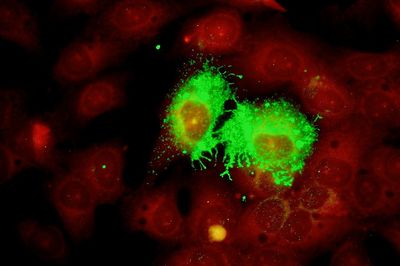Canine distemper is a highly contagious disease of canines and weasels. It is caused by the Canine distemper virus - CDV of the family Paramyxoviridae, genus Morbillivirus, which is closely related to the bovine fever virus or human measles virus.
Canine distemper is transmitted directly via contact between the individual animals or indirectly via aerosol droplets. The disease can take several forms; depending on which organ the virus has infected, the disease can present as nervous, pulmonary, gastrointestinal or cutaneous form. These forms may occur alone or the disease can present in generalized form. Mortality is as high as 50-80% in dogs and up to 100% in ferrets. The animals that survive the infection often face lifelong consequences. As the therapy of this infection is only symptomatic, prevention in the form of vaccination is important.
The genome of canine distemper virus encodes 6 structural proteins. The gene encoding hemagglutinin (H-gene) is characterized by high heterogeneity and therefore appears to be the most suitable for molecular-epidemiological examination of the virus. Based on the phylogenetic analysis of hemagglutinin (H) gene sequences and their variability, canine distemper virus is classified into genetic lineages. At least 17 well-defined canine distemper virus lineages have been identified worldwide, designated as America-1 (vaccine strains), America 2-5, Europe 1 / South America, Europe 2 / wildlife, Europe 3 / Arctic like, America1 / Europe , Asia 1-4, Rockborn like virus, South Africa and South America 2 and 3.
Various species of carnivores are susceptible to infection with the canine distemper virus; of our wild carnivores mainly the fox, the badger and both species of martens being relevant. It is wild animals that can currently pose a risk of infection to unvaccinated pets. Our laboratory performs not only the diagnosis of canine distemper in domestic and susceptible wild animals, but also the sequence analysis of CDV positive samples. Monitoring the presence of canine distemper virus and characterization of the isolates makes it possible to elucidate the routes of spread of the virus in wild carnivore populations in different regions of Europe and at the same time makes it possible to detect interspecies and wild-to-domestic and wild-type transmissions. Molecular analysis is also important for the detection of new virus variants. The study will then be used to map the current disease situation in the Czech Republic.




